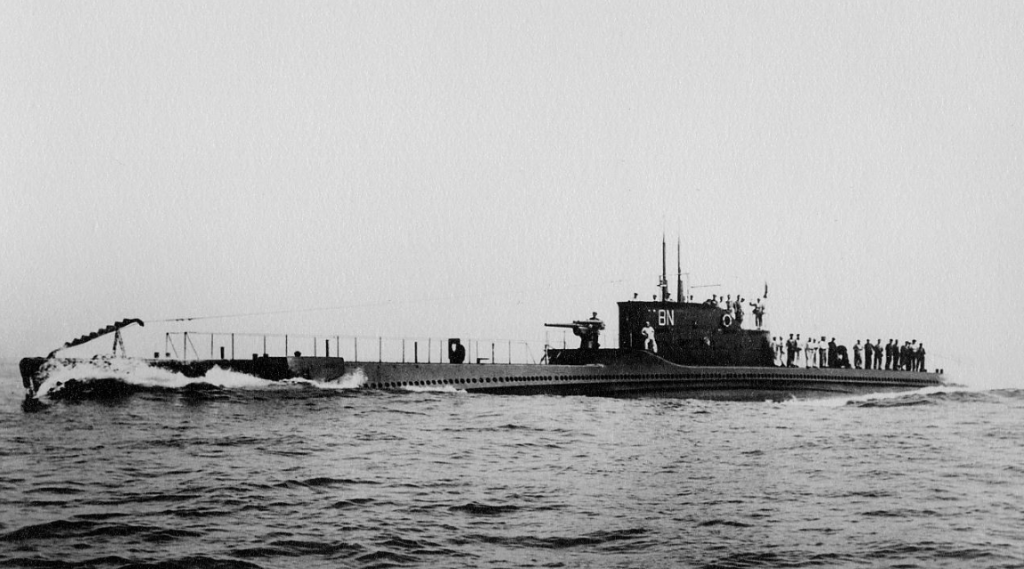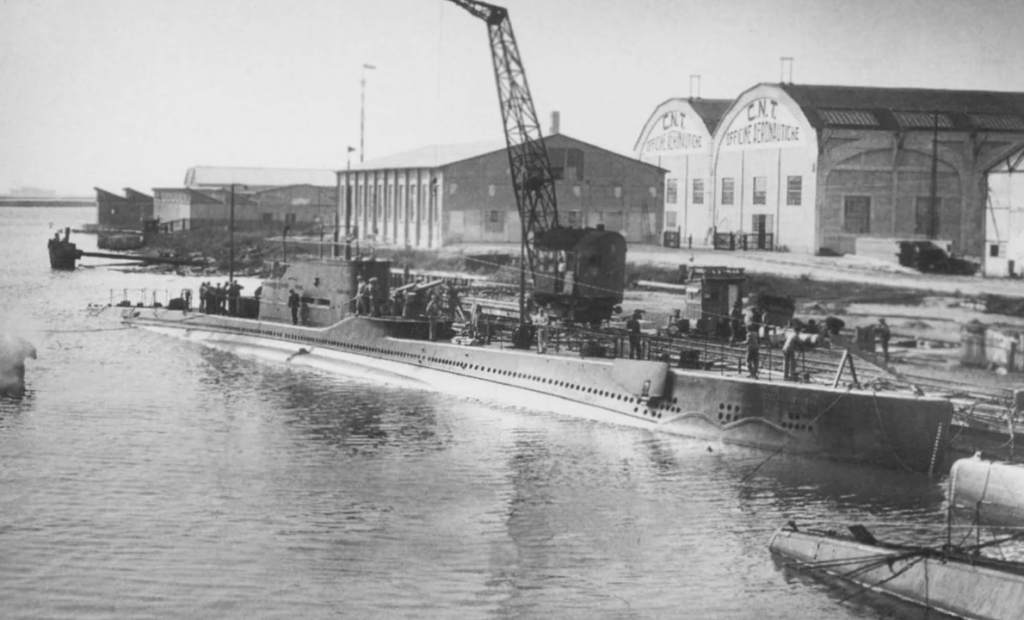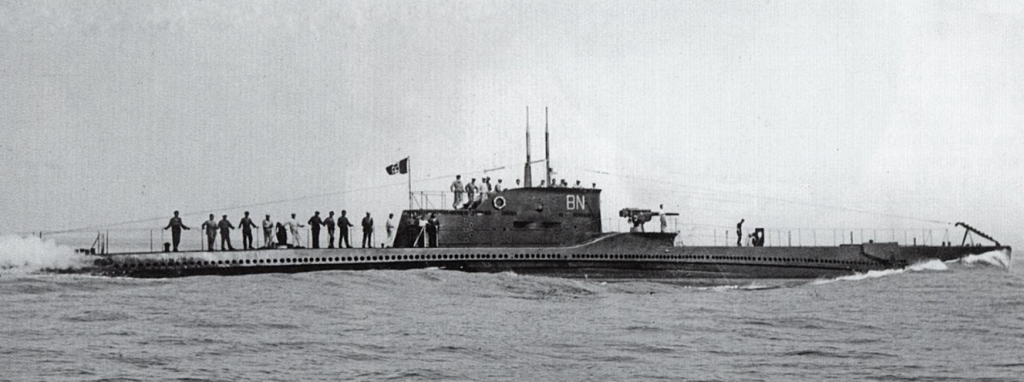Giovanni Bausan was a medium-cruising submarine of the Pisani class (displacement of 880 tons on the surface and 1,058 submerged). During the boat’s very short period of active service in World War II (just over a month) it completed 3 offensive/exploratory patrols and 5 transfers, covering a total of 2,593 miles on the surface and 198 submerged. From January to October 1941, it then carried out 90 training sorties in the Upper Adriatic for the Submarine School of Pula.

The submarine Giovanni Bausan, named after an officer of the Neapolitan navy (1857-1821)
Brief and Partial Chronology
January 20th, 1926
Bausan was laid out at the Trieste Shipyard in Monfalcone (construction number 152). During construction, Bausan was visited by the Russian designer Boris Mikhailovich Malinin (who designed most of the Soviet submarine classes of the interwar period), who was part of a Soviet delegation, which incorporated the information from this visit into the design of the new submarines of the Dekabrist class, built for the Soviet Navy between 1927 and 1929.
March 24th, 1928
Bausan was launch at the Trieste Shipyard in Monfalcone. Placed under the command of the Marine Command of Pula, it remains in Monfalcone for the outfitting and testing, at the shipyard.

Bausan’s launch
(From “Gli squali dell’Adriatico. Monfalcone e i suoi sommergibili nella storia navale italiana” by Alessandro Turrini)
March 1929
During the tests, Bausan reached a test depth of 105 meters (TN considerable for the period).

Bausan being fitted in Monfalcone
September 15th, 1929
The boat entered service. Due to serious problems with transverse stability that had soon emerged, all the units of the class had to be modified with the application of lateral additional saddles at the level of the waterline, which however reduced their overall performance (reduction of the surface speed by 2 knots, and of the submerged speed by 1 knot). Other problems concern the diesel engines, which continue causing problems throughout the operational life of submarines of the class.
Bausan was assigned with the boat of the same class (Vettor Pisani, Marcantonio Colonna and Des Geneys) to the V Submarine Squadron of Medium Cruise, based in Naples, with which the boat completed trials and began training.
Among the officers assigned to the first crew of Bausan was the then midshipman Carlo Fecia di Cossato, a future ace of the Battle of the Atlantic, fresh from the academy, Bausan was his first assignment. During his service on board, Fecia di Cossato did not fail to detect the multiple problems that afflicted the Pisani-class submarines, suggesting operational solutions to mitigate them.
November 4th, 1929
Bausan received in Gaeta (the birthplace of the eponymous officer) the combat flag, donated by the city.
1930
The commander of Bausan was Lieutenant Commander Giovanni Marabotto.

Bausan in 1930
(From “Storia Militare”)
September 1930
Together with the boats of the same class, Bausan carried out a long training cruise in metropolitan waters and in the eastern Mediterranean, calling at several Italian and Greek ports (such as Volos and Thessaloniki) as well as in the Dodecanese.
May 2nd and 3rd, 1932
During the night between May 2nd and 3rd, during a training cruise, Bausan ran aground in the Marmorata Islands, near Punta Falcone (Sardinia, Strait of Bonifacio), but managed to free itself without assistance from other units, at 4.36 AM On May 3rd.
1935
Bausan and the boats of the same class were transferred to La Spezia, in a squadron belonging to the I Submarine Group.
ca. 1935
Bausan, while submerged in the Gulf of La Spezia, was used for a test escaping from a submerged submarine through a watertight chamber and a torpedo tube, as part of the first tests for what will become the Slow Running Torpedoes (SLC), invented by the captains of the Naval Engineers and Naval Weapons Teseo Tesei and Elios Toschi. The idea is that the operator destined to pilot the SLC exits the submerged submarine through the torpedo tube, to reach the craft to be piloted. The tests were carried out in the utmost secrecy.
According to a source (not verified), Bausan waslater chosen also for a hypothetical plan of attack against the base of Alexandria in Egypt (May 1940) using the “frogmen”. The plan involved using the now old and “expendable” Bausan to bring a group of divers armed with compressed air scissors to the mouth of the Egyptian port, with which they would break through the obstructions of the entrance to the port, and then penetrate and attack the British units moored there. However, the plan was abandoned because it was considered too desperate and because it would have induced the British to strengthen the port defenses of Alexandria, thus compromising the subsequent and better planned attacks by SLCs, which were ready for action before the end of the summer of 1940.
1936
Bausan was stationed in Leros, assigned to the II Submarine Squadron of the VI Grupsom.
January 22nd, 1937
Bausan (Lieutenant Commander Giovanni Onnis) set sail from Cagliari to carry out a clandestine mission in support of Franco’s forces during the Spanish Civil War. The assigned area was off the coast of Cabo de Gata (Andalusia, near Almería).
January 28th, 1937
Even before being able to reach the area assigned for the mission, Bausan was forced to return to Cagliari due to a breakdown, without having encountered any enemy ships.
1938
Bausan and the boats of the same class were transferred to Messina, forming the III Submarine Squadron (III Submarine Group).
May 5th, 1938
Bausan took part in the naval magazine “H” organized in the Gulf of Naples for Adolf Hitler’s visit to Italy.
June 10th, 1940
When Italy entered the war, Bausan belonged to the XXXI Submarine Squadron (III Grupsom of Messina), together with the boats of the same class Vettor Pisani, Des Geneys and Marcantonio Colonna. Being relatively old (over ten years of operational life) and of mediocre characteristics since construction, it was soon excluded from “front-line” offensive activity.
Immediately after the declaration of war (according to another source, however, on June 9th, even before the declaration of war), Bausan (Lieutenant Commander Francesco Murzi) was sent to lie in wait off Malta.
June 13th, 1940
Around seven o’clock in the morning, three miles by 090° from Cape Santa Croce, Bausan, on its way back to Augusta on its way back from its first war patrol, sighted a torpedo that was avoided with a lightning maneuver, passing only ten meters forward of the submarine.
It is possible that the torpedo was launched by the British submarine H.M.S. Grampus (Lieutenant Commander Charles Alexander Rowe), which at that time was off the coast of Augusta, where a few hours later it laid a minefield. However, H.M.S. Grampus did not communicate by radio that it had carried out a torpedo attack, and never returned from its mission, being sunk without survivors, on June 16th, by the Italian torpedo boats Circe, Pollux, Calliope, and Clio. Thus, it is not possible to have confirmation or denial that it was the author of the attack, although it seems likely. However, it is not impossible, as has happened on countless occasions in all the navies, that the crew of Bausan mistook something that was not for a torpedo trail (for example, a porpoise).
June 20th through 24th, 1940
Bausan was sent on a mission off Cape Krio to patrol the Cerigotto Channel, but it had to interrupt the mission and return to port due to a serious failure of the forward planes.
July 14th though 21st, 1940
The boat was sent to lie in wait in the Strait of Sicily, between Pantelleria and Cape Bon, and it was again hit by a serious failure, this time to the electric propulsion motors, and has to interrupt the mission and return to base.
August 1940
Bausan was sent to Rijeka, where it would spend a few months. During this period (September-October 1940), Commander Murzi was chosen to be embarked on a German submarine, U 37, to participate in a mission in the Atlantic and thus observe the tactics in use by the German Navy. At the end of this assignment, Murzi returned to command Bausan.
Following a succession of breakdowns in the summer of 1940, it was concluded that Bausan was now a poorly efficient boat, too old, worn out and unreliable to be able to use it further in war activities. The submarine was then assigned to the Submarine School in Pula to be used for training.
January 1st through 8 October 8th, 1941
Bausan made a total of 90 sorties to the Upper Adriatic for the training of new submariners, employed by the Submarine School of Pula. (According to another source, he was not assigned to the Submarine School until February 1941.)

Bausan with the mimetic paint scheme
The intense training activity carried out on behalf of the Submarine School further eroded the already reduced efficiency of Bausan, which by the end of the year was no longer considered suitable even for this kind of service.
November 1941
According to one source, Bausan was laid up in Pula this month, while several others (most of them) indicate that it was decommissioned on May 18th, 1942. Its 102/35 mm gun was landed and destined, together with those taken from the boats of the same class Colonna and Des Geneys, to arm the motor ship Himalaya, which was being transformed in Bordeaux into a support ship for the Italian submarines of Betasom, operating in the Atlantic. The transformation of the Himalayas, however, was never completed.
May 18th, 1942
Different sources indicate that this was the date Bausan was stricken (which, according to other sources, had already taken place the previous November. The USMM’s (Italian Naval Historical Bureau) “Lost Naval Ships” describes it as having been decommissioned on May 18th, 1942) or its decommissioning (which, however, would not have formally occurred until October 18th, 1946). Other sources give the date as April 16th, rather than May 16th.
During the same year, Bausan was transformed into a fuel barge, moored in Rijeka, with the new name of G.R. 251 (“GR” means Supply Float, a type of boat registered in the Register of Ships, which includes port barges and floating tankers used for refueling in ports). Thus ended its operational life: it spent the rest of the conflict as a floating fuel depot.
The end
According to vague and uncertain sources, the former Bausan was scuttled in Pula on September 9th,1943, following the announcement of the armistice, while according to others it survived the conflict and was scrapped after the war after its formal decommissioning, which took place on October 18th, 1946; both versions are wrong.
The final period of Bausan’s life, as for other unarmed submarines reduced to barges, is rather obscure. On March 1st, 1943, G.R. 251 (sometimes also referred to in documents as GR. 241 or GRS. 241) was in Brindisi; it was probably still here at the date of the armistice, thus remaining in territory controlled by the Allies.
In the spring of 1944, the British decided that the former Bausan would be an excellent target for night bombing exercises by RAF bombers equipped with radar. On June 9th,1944, therefore, the submarine-barge was towed to a point off Barletta, where it was anchored, and used as a target by British aircraft, until it was sunk.
Thus ended, violently but without fanfare or victims, the fifteen-year career of the submarine Giovanni Bausan. No trace of its sinking remains except in a few British documents, half-buried in the archives. The existence of its wreck off the coast of Barletta was soon forgotten, so much so that when in August 1999 the wreck of an unknown submarine, already known for some time to local fishermen who lost their nets (entangled in the propellers), was identified about ten miles north of Barletta by some divers from Bisceglie (including Ennio Padalino), in position 41°29′ N and 16°16′ E, this was mistakenly identified as H.M.S. Regent, a British submarine that had disappeared in the Adriatic with all its crew in April 1943. The identification had even been accepted by the British authorities, who declared the wreck a war grave.
In June 2020, a series of dives by a group of divers composed of Fabio Bisciotti, Alessandro Aulicino, Michele Favaron, Stefania Bellesso, Ruggero Nanula, Pietro Amoruso and Pasquale Bailon made it possible to trace the true identity of the Barletta wreck: it is not H.M.S. Regent, but the Giovanni Bausan.
The wreck lies at a depth between 28 and 37 meters, without the deck gun and in very poor condition. Half buried in the mud of the seabed and difficult to recognize. Several gashes and other damage are visible on the hull, caused by the bombs dropped by Allied planes during the exercises, while two hatches are recognizable at the bow.
Original Italian text by Lorenzo Colombo adapted and translated by Cristiano D’Adamo
Operational Records
| Type | Patrols (Med.) | Patrols (Other) | NM Surface | NM Sub. | Days at Sea | NM/Day | Average Speed |
|---|---|---|---|---|---|---|---|
| Submarine – Medium Range | 8 | 2593 | 198 | 19 | 146.89 | 6.12 |